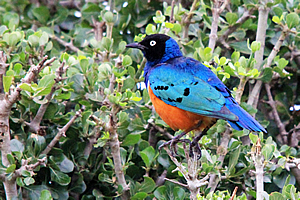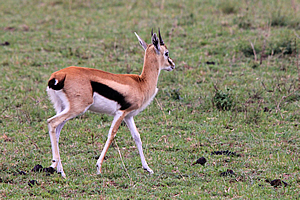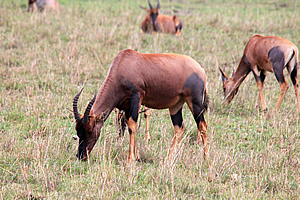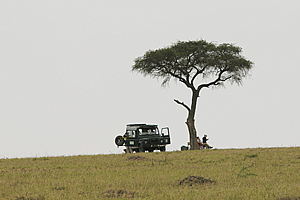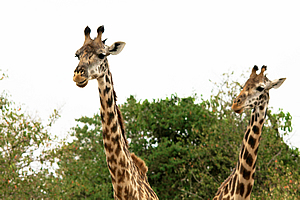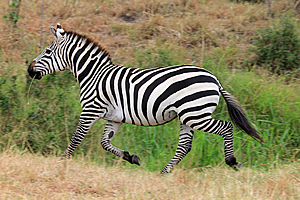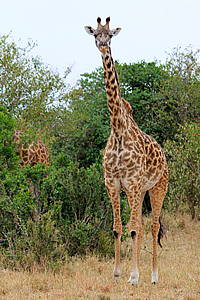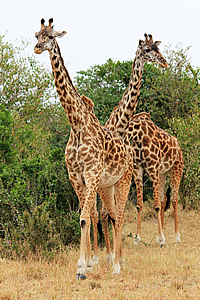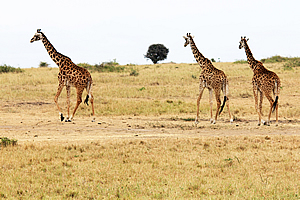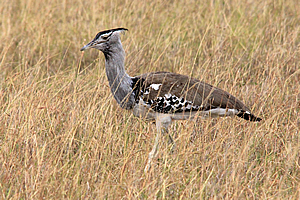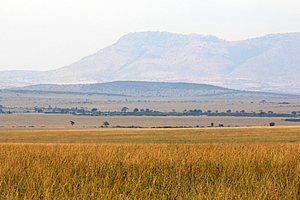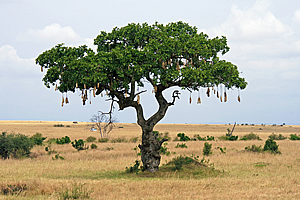--- Archive files ---
Home > Travels > Masai Mara > 10 |
Across the Vast Grassy Plains
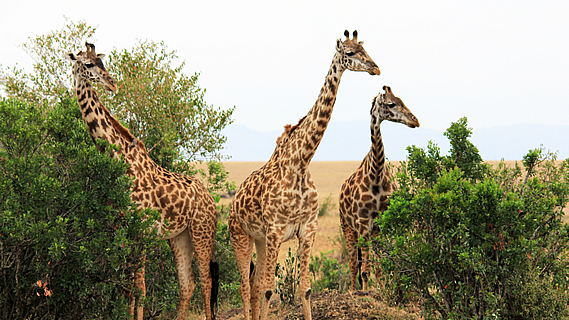
THE TRACK became rather bumpy as we passed another small herd of zebra. Then we saw a group of wildebeest galloping along in amongst the short grass. We were in a small convoy following another two vans along the gravel road. The road split into two, the side road had a small sign saying there was another eco camp nearby, but it must have been over the next hill as I couldn't see it. We continued along the main gravel road having to slowly pass another herd of zebra and wildebeest before stopping in an area where a lot of vans had parked. There were plenty of zebra and wildebeest here at what had been a pond but was now no more than a salt lick. There really wasn’t anything else of interest that would attract such a large gathering of vans. Perhaps this was just a random coincidence of lots of vans suddenly meeting together at the same place.
Starling |
By now the cloud cover was definitely mid-level at around four thousand metres high. Some areas were starting to break up into altostratus, but not enough to see any blue sky.
We continued for about two hundred metres before stopping at a couple of small scruffy trees. One of the trees had several brightly coloured starlings in it. I recalled seeing one yesterday, but these were a lot closer. They were as brightly coloured as the macaws I had seen in the Amazon last year. Their backs had solid dark blues and greens, their fronts were a rust red colour. They had silver rings around their eyes and their heads and tails were a navy blue. They were very beautiful creatures. Throughout our ten minutes there they stayed resting in the tree. Perhaps there was a food source for them there.
Gazelle |
We continued up the hill until reaching nearly the top. Here it was just grass with no trees. The hill had many gazelles on it. I was surprised with how small they were. They were leopard food. There were two types, the Thompson’s gazelle and the great gazelle. The main differences between them were the Thompson’s gazelle was smaller and it had a whiter behind.
The males of both varieties had black horns rising vertically above their heads. The younger ones had short horns and some of the older ones had a horn that had snapped off – obviously a sign of a lost battle in the past. They were all quietly foraging the very short grass. Clearly they were a long way from the cheetah so they had nothing to worry about.
Waterbucks |
We then passed a field of waterbucks grazing in the grass amongst another herd of Thompson’s gazelle. It was very serene here away from the stress of nearby predators.
From here we continued along the trail for several kilometres. Up till now we had constantly seen animals everywhere, but here we passed almost an entire kilometre without seeing any animals at all. The grass here was pretty short, so animals must have grazed here recently, but they had obviously moved on.
Picnic under a tree |
Then we saw a lone tree on a low hill about two hundred metres away. Under the tree sat a jeep and a couple of people outside eating morning tea. I thought that was pretty brave of them being outside here exposed to potential predators.
A few hundred metres further down the hill we ran into a large herd of wildebeest with a number of gazelles and a few zebra interspersed amongst them.
Giraffe |
We descended a large hill and reached an area of scrub where there were numerous zebra and giraffe chewing on the foliage of a small thicket. Several other vehicles had stopped here.
The zebra were eating the lower foliage and the giraffe were eating the foliage at the top. The giraffe towered above the foliage. Some of the zebra ran off together towards another thicket. Then the giraffe started making their way across the road heading towards another part of the park. They seemed somewhat uneasy as they galloped across the roads. Their extremely tall bodies required a lot more balance than other hoofed animals. They towered to more than twice the height of the vans they passed – even with their pop tops open.
Zebra |
Once across the road they gradually headed across the long grass of a large field that had not been grazed for a long time. I’m sure any herbivore could have relished the long untouched grass, but only the giraffe would be able to see over it well enough to see if there were any predators lurking within it. Any shorter animal would be putting itself into a lot of serious danger.
A little further up the track were two vultures sitting in the branches of a small tree, looking out across the fields for some prey. There were no other animals here, nor would there be for some distance.
Giraffe |
Giraffe |
We continued along the trail for another kilometre before Joseph decided he wanted to relieve himself. He stopped the van, walked out to the back to it and did his business. Then fortunately he returned to the van safety to continue the tour.
Giraffe |
We started crossing a large area of long grass that didn't seem to have any animals, but in the grass in the distance we saw a large bird, the kori bustard. Joseph explained that at nineteen kilogrammes this was the heaviest flying bird in the world. It wasn’t a good flyer at all, but it could fly nonetheless. It stands seventy one to a hundred and twenty centimetres tail and has a wingspan of around two and a half metres. Although they fly, they do spend most of their time on the ground on the savannahs. They are reclusive animals fleeing at any sign of disturbance, so we were lucky to be seeing one.
Kori bustard |
The grass there was very long and there were no other animals around. Clearly this area hasn’t been grazed for a long time. The bird wandered slowly through the thick grass looking for insects to eat. We stopped and watched it forage for a few minutes before moving on.
A little further up the track the grass was shorter and there were a lot of zebras and wildebeest chewing away in the long grass although it was rather dead. There were a few waterbucks interspersed amongst them.
Vast fields of grass |
Nearby were a group of white backed vultures and a couple of storks. The vultures were feeding off a carcass.
We followed the hills and to my surprise we didn’t see any animals for quite a long time. We continued over the rolling hills for another ten minutes before I needed a toilet break. I was a bit nervous about getting out of the van to near the long grass where anything could be lurking. Then I realised that fear was totally irrational. I had walked alone between my tent and the dining cabin at the eco-lodge yesterday, and I had done the long walk with Luke and Samuel the Masai warriors for two hours yesterday in an area that had a lot more animals than this area. Surely there can’t be anything wrong here. We stopped and I went out anyway. Fortunately nothing got me.
Strange tree |
We had stopped near a small black swamp with a big tree on its bank with large seed heads hanging almost unnaturally down off it. The black swamp had once been a fairly large pond but was now dried up with nothing more than a cracked black dry crust of rotting vegetation covering the surface. I climbed back onto the van and we continued along through the hills.
<< Previous | Next >> |
|
||
About this Page
|
||
|
|
|
Where is Walkabout Jeff? |
|
|
|
|
What is happening in Walkabout Jeff's hometown?
|
|
|
|
|
Who is Walkabout Jeff?Any normal person's idea of going out involves going to the local pub for a drink with a few mates. Walkabout Jeff isn't normal.
|
|
|
|
|
